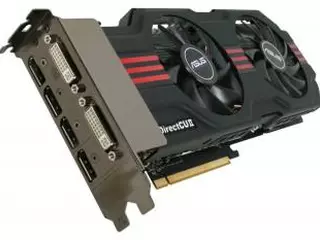Qualcomm Adreno 680 vs Radeon HD 6950
If you are going to buy a new graphics card and are choosing between Qualcomm Adreno 680 and Radeon HD 6950, there are a couple of things to consider. Cards with more VRAM in general perform better and allow you to play on higher graphics settings. Size also makes a difference. A model with a large heatsink can occupy up to three expansion slots on a motherboard. Be sure you have enough room in your PC case. When comparing GPUs with different architectures, more processing cores and even higher TFLOPS will not always translate to better performance. To help you decide which GPU you need, we have measured frame rates in a number of popular games. For more on how the Qualcomm Adreno 680 stacks up against Radeon HD 6950, check out specs charts below.
Qualcomm Adreno 680 is a Laptop Graphics Card
Note: Qualcomm Adreno 680 is only used in laptop graphics. It has lower GPU clock speed compared to the desktop variant, which results in lower power consumption, but also 10-30% lower gaming performance. Check available laptop models with Qualcomm Adreno 680 here:
Main Specs
Qualcomm Adreno 680
Radeon HD 6950
Power consumption (TDP)
500 Watt
Interface
PCIe 2.0 x16
Supplementary power connectors
2x 6-pin
Memory type
GDDR5
Maximum RAM amount
2 GB
Display Connectors
2x DVI, 1x HDMI, 2x mini-DisplayPort
Check Price
Check Price
Qualcomm Adreno 680 is used in Laptops, and Radeon HD 6950 - in Desktops.
Qualcomm Adreno 680 is manufactured by 7 nm process technology, and Radeon HD 6950 - by 40 nm process technology.
Game benchmarks
Assassin's Creed Odyssey
Battlefield 5
Call of Duty: Warzone
Counter-Strike: Global Offensive
Cyberpunk 2077
Dota 2
Far Cry 5
Fortnite
Forza Horizon 4
Grand Theft Auto V
Metro Exodus
Minecraft
PLAYERUNKNOWN'S BATTLEGROUNDS
Red Dead Redemption 2
The Witcher 3: Wild Hunt
World of Tanks
high / 1080p
0−1
14−16
ultra / 1080p
−
8−9
QHD / 1440p
0−1
3−4
low / 720p
1−2
27−30
medium / 1080p
0−1
16−18
The average gaming FPS of Radeon HD 6950 in Assassin's Creed Odyssey is 2700% more, than Qualcomm Adreno 680.
high / 1080p
−
21−24
ultra / 1080p
−
18−20
QHD / 1440p
0−1
5−6
4K / 2160p
−
5−6
low / 720p
0−1
45−50
medium / 1080p
−
24−27
low / 768p
50−55
45−50
high / 1080p
45−50
−
QHD / 1440p
0−1
0−1
The average gaming FPS of Qualcomm Adreno 680 in Call of Duty: Warzone is 10% more, than Radeon HD 6950.
low / 768p
60−65
200−210
medium / 768p
27−30
170−180
ultra / 1080p
7−8
90−95
QHD / 1440p
−
50−55
4K / 2160p
−
30−33
high / 768p
16−18
130−140
The average gaming FPS of Radeon HD 6950 in Counter-Strike: Global Offensive is 439% more, than Qualcomm Adreno 680.
low / 768p
70−75
55−60
ultra / 1080p
0−1
35−40
medium / 1080p
45−50
45−50
The average gaming FPS of Qualcomm Adreno 680 in Cyberpunk 2077 is 15% more, than Radeon HD 6950.
low / 768p
45−50
100−110
medium / 768p
10−11
90−95
ultra / 1080p
0−1
60−65
The average gaming FPS of Radeon HD 6950 in Dota 2 is 237% more, than Qualcomm Adreno 680.
high / 1080p
−
16−18
ultra / 1080p
−
14−16
4K / 2160p
−
6−7
low / 720p
0−1
35−40
medium / 1080p
−
18−20
high / 1080p
−
21−24
ultra / 1080p
−
18−20
QHD / 1440p
−
16−18
low / 720p
21−24
90−95
medium / 1080p
0−1
45−50
The average gaming FPS of Radeon HD 6950 in Fortnite is 318% more, than Qualcomm Adreno 680.
high / 1080p
0−1
24−27
ultra / 1080p
−
18−20
QHD / 1440p
0−1
8−9
low / 720p
0−1
45−50
medium / 1080p
0−1
27−30
low / 768p
18−20
80−85
medium / 768p
−
70−75
high / 1080p
0−1
27−30
ultra / 1080p
−
10−12
QHD / 1440p
0−1
2−3
medium / 720p
12−14
−
The average gaming FPS of Radeon HD 6950 in Grand Theft Auto V is 331% more, than Qualcomm Adreno 680.
high / 1080p
−
9−10
ultra / 1080p
−
7−8
4K / 2160p
−
2−3
low / 720p
0−1
27−30
medium / 1080p
−
12−14
low / 768p
75−80
110−120
high / 1080p
27−30
−
ultra / 1080p
−
100−110
medium / 1080p
−
100−110
The average gaming FPS of Radeon HD 6950 in Minecraft is 49% more, than Qualcomm Adreno 680.
high / 1080p
−
21−24
ultra / 1080p
−
16−18
low / 720p
8−9
50−55
medium / 1080p
−
21−24
The average gaming FPS of Radeon HD 6950 in PLAYERUNKNOWN'S BATTLEGROUNDS is 550% more, than Qualcomm Adreno 680.
high / 1080p
−
14−16
ultra / 1080p
−
9−10
QHD / 1440p
−
0−1
low / 720p
0−1
24−27
medium / 1080p
−
14−16
low / 768p
0−1
50−55
medium / 768p
−
30−35
high / 1080p
−
16−18
ultra / 1080p
−
10−11
4K / 2160p
−
8−9
low / 768p
45−50
100−105
medium / 768p
14−16
60−65
ultra / 1080p
0−1
30−35
high / 768p
12−14
50−55
The average gaming FPS of Radeon HD 6950 in World of Tanks is 188% more, than Qualcomm Adreno 680.
Full Specs
Qualcomm Adreno 680
Radeon HD 6950
Architecture
TeraScale 3
Code name
Cayman
Type
Laptop
Desktop
Release date
6 December 2018
14 December 2010
Pipelines
1408
Boost Clock
800 MHz
Transistor count
2,640 million
Manufacturing process technology
7 nm
40 nm
Texture fill rate
70.40
Floating-point performance
2,252.8 gflops
Length
267 mm
Memory bus width
256 Bit
Memory clock speed
1250 MHz
Shared memory
+
DirectX
DirectX 12
Shader Model
5.0
OpenGL
4.4
OpenCL
1.2
Bus support
PCIe 2.0 x16
HDMI
+
Bitcoin / BTC (SHA256)
244 Mh/s
Eyefinity
+
Design
reference
CrossFire
+
Check Price
Check Price

